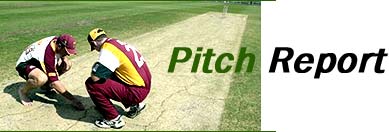
Saurashtra Cricket Association
Date of inspection : 14 September 2002
Present : Niranjan Shah (BCCI Hon Secretaty)
Yogesh Shah (Coordinator SCA)
Mahendra Rajdev (Curator)
Rasik Makwana (head of groundstaff)
Vijay Doshi
Shifish Buch
Dhiraj Parsana (BCCI Grounds and Wickets - West)
Kasturi Rangan (BCCI Grounds and Wickets - Chairman)
Bill Walmsley (NZ Sports Turf Institute)
-----------------------------------------------------------------------------------------------------------------
Present condition of ground
The ground is a one - day cricket centre, owned by the Municipal Government. It receives about 120 days of cricket per year. The cricket square is constructed from a mixture of 4 parts black soil to 1 part red soil. Black soil is collected from the bottom of water ponds, while red soil is local to the area. Construction and establishment of the cricket square began well ahead of all other grounds, and has been completed to a high standard.
All that remains is for a few weak patches to establish and for pre - season rolling to begin.
The outfield is reasonably smooth and well-grassed.
Prospects for sporting pitches
I am optimistic that the mixture of 4 parts black soil to 1 part red soil used in the cricket square, has the potential to produce good pitches (Appendix 2). Pitch preparation will have a large bearing on pitch performance.
Great care should be taken in the selection of the soil for the cricket pitch. I would like to see one of the pitches topdressed with black soil only, to compare its performance to the mixture with red soil. I would like to see more investigation of the different black soils that might be available.
Limitations on producing a quality outfield
It is reported that the outfield tends to be rather hard. It is proposed to topdress the outfield with river sand in an attempt to create a softer surface.
The sand has a considerable content of coarse stone which may damage mowing equipment and possibly add to the injury hazard for players. I prefer that the outfield is topdressed with a softer or sandier red soil than the one currently used. If necessary, add a composted material (coir or similar) to the red soil.
What would have the greatest effect on the quality of the outfield is more irrigation and fertilization.
I have recommended that all grounds investigate the feasibility of installing pop-up irrigation. With the ground ownership uncertainties, this may not be feasible, but at the very least I recommend upgrading the portable sprinkle irrigation equipment currently used so the ground can be fully irrigated in a shorter period time.
The supply of water may also need to be investigated.
Equipment limitations
There is a good range of rollers available. The electric outfield mower needs to be replaced with three petrol-powered models, plus a dedicated cricket pitch mower (Appendix 7).
The outfield sprinkler irrigation system needs upgrading, either to a pop-up system or to a new system of larger portable sprinklers with a much higher capacity output.
Organisation limitations to producing a high quality cricket venue
The ground is owned by the Municipal Government. This presents problems with maintenance and development. I suggest that cricket attempt to negotiate a long term lease of the ground so they can benefit from any improvements they put into the ground.






